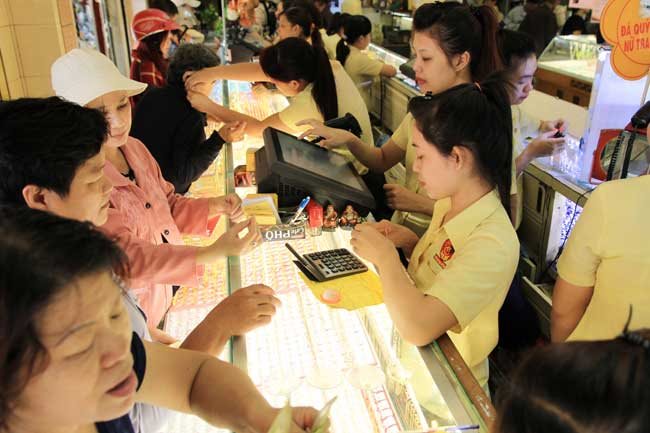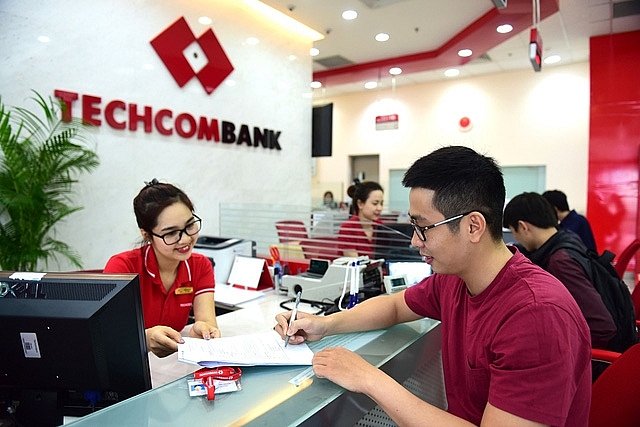Downward exchange rate scenario
Downward exchange rate scenario
The exchange rate is in a stable stage thanks to ample foreign currency supplies. Early this year, the rate was forecast to face much pressure from unpredictable developments of the global financial market, but the current situation shows that it seems to be stable, and even to go down this year.

The dong-U.S. dollar rate in 2019 appears to be in complete contrast to the picture in 2018. The rate last year was greatly affected by the Sino-U.S. trade war, but it is stable this year, even amid tit-for-tat tariff imposition by the world’s two largest economies. This development has derailed experts’ forecasts early this year that the dong will depreciate 3% against the dollar in 2019.
The two factors of foreign currency and dong demand and supply have brought the exchange rate to a low, stable level amid the escalation of the trade war. Foreign currency supply is the most ample ever. The trade balance has continuously gained a surplus while foreign investment has reached new records.
The trade surplus in August was US$3.4 billion, bringing the total surplus in the first eight months to US$5.4 billion, higher than the surplus of US$4.7 billion in the same period last year. In addition, accumulative direct foreign investment in the eight-month period reached US$12 billion, rising 6.3% year-on-year, and foreign investment through capital contribution and share purchase amounted to US$9.5 billion, up 80% year-on-year. The ample foreign currency supplies have helped banks maintain their foreign currency positions at over US$1 billion.
The exchange rate has remained stable even when the State Bank of Vietnam (SBV) has bought a large amount of foreign currency. The stability results from the relatively firm market sentiment. Despite tit-for-tat measures during the trade war that have made the Chinese yuan plunge to 7.1 yuan per U.S. dollar, the dollar-dong rate has just inched up slightly and later fallen to the SBV’s buying price of VND23,200 per dollar. The parallel exchange rates have been out of step with each other. Of note, while the Chinese yuan has continuously lost its value amid the stable dong, foreign currency inflows into Vietnam remain large and do not have sign of reversal.
So, it can be assumed that the trade war will no longer be a heavy pressure on the exchange rate. In addition, the U.S. Federal Reserve’s continuous cut of the interest rate for the U.S. dollar this year has prompted forecasts for a weaker dollar, which would further reduce pressure on the exchange rate.
As such, the dong-dollar exchange rate has favorable conditions for stability and is forecast to be stable throughout this year. The inter-bank exchange rate is likely to move between VND23,190 and VND23,300 per dollar. This is the benchmark for setting the foreign currency buying and selling prices between banks and the public and enterprises.
Low rate concerns
Last year, a stable exchange rate was really the expectation of the money regulator and import-export enterprises. If the rate had been stable, the SBV would not have had to spend billions of U.S. dollars to reduce the pressure on the exchange rate. Meanwhile, at the present time, the exchange rate is low and stabilized around the SBV’s dollar buying price, a situation which may spark concern over the possibility of Vietnam being put in the list of currency manipulators by the United States.
The three criteria to label a currency manipulator are over US$20 billion in surplus in annual trade with the U.S., a current account surplus of over 2% of the GDP and the amount of foreign currency purchased within six and 12 months being over 2% of the GDP. Vietnam had a surplus of around US$30 billion in trade with the U.S. in the first eight months of this year, meeting the first criterion. The surplus may be maintained throughout the year as the U.S. is still the largest market for Vietnam’s exports.
One important factor that the SBV should consider to avoid the currency manipulator labeling is to maintain the amount of foreign currency purchased with six and 12 months in succession at below 2% of the GDP. However, the exchange rate this year is stabilized around the SBV’s dollar buying price, enabling the central bank to make continuous dollar purchases to increase the foreign reserves. The heavy dollar purchase to interfere with the downward trend of the exchange rate may bring Vietnam into the currency manipulator list.
Furthermore, a low exchange rate amid a weak Chinese yuan is also a concern for Vietnam-China trade balance when China is still the largest exporter to Vietnam.
Nevertheless, during the periods of strong Chinese yuan depreciation, at time at nearly 7.2 yuan per U.S. dollar, while the dong remained stable at VND23,200 per dollar like in August, Vietnam still gained a record trade surplus. This phenomenon shows that the dong-yuan purchasing balance has yet to affect greatly the trade balance though China is the largest exporter to Vietnam. This is obviously the ground to hope that the low exchange rate does not affect greatly the import-export trade. The impact of the trade war on trade flows probably dominates the effect of the currency purchasing power.
It should be noted that the U.S. criteria for currency manipulation are aimed to reduce deficit in bilateral trade with partners through the exchange rate “play card.” U.S. President Donald Trump is probably the keenest in this effort when he continuously called for a reduction in the U.S. dollar interest rate to weaken the dollar and improve the trade balance. Therefore, countries wishing not to be included in the currency manipulator list should not weaken their local currencies against the dollar, or to increase the purchasing power of their currencies.
If the purchasing power of the dong against the U.S. dollar or the Chinese yuan does not affect much the foreign currency inflow into Vietnam as mentioned above, the country can absolutely reduce slightly the exchange rate, i.e. to increase the purchasing power of the dong against the dollar and the yuan. This effort can help reduce trade surplus with the U.S. on one hand, and shows that Vietnam is adjusting the exchange rate in favor for the U.S. trade on the other hand.
To achieve this goal, the SBV may slightly cut the U.S. dollar buying price to VND23,190 per dollar, which would pull down the inter-bank exchange rate when the foreign currency position of banks remain positive at the present time.
Theoretically, the exchange rate reduction will affect the overall import-export trade, not only trade with the U.S. It will also have an impact on foreign capital flows. Still, a slight cut of the dollar buying price is the most effective measure if Vietnam wants to reduce the exchange rate to avoid being labeling a currency manipulator.
















